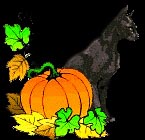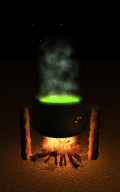|
|

Origins of the Halloween Traditions
Many of our Halloween traditions today can be traced all the way back to Celtic antiquity and Pagan traditions. Some that are thought to be quite old are actually more recent in origin. Because much of our folklore was passed down through the years verbally, stories will vary, and more than likely different scholars will argue about true origins forever. The following are the probable origins of the elements of Halloween as we celebrate it today.
JACK O LANTERNS

According to Irish folklore, there once lived a man named Jack who was known for being a drunk and a prankster. One night Jack tricked the devil into climbing a tree, and quickly carved an image of a cross on the trunk, trapping the devil. Jack then made him promise that, in exchange for letting him out of the tree, the Devil would never tempt him to sin again. He reluctantly agreed, but was able to exact his revenge upon Jack's death. Because of his mischevious ways in life, Jack was barred from entering heaven and because of his earlier trick, he was also barred from hell. So he was doomed to wander the earth until the end of time, with only a single ember (carried in a hollowed out turnip) to warm him and light his way.
In Ireland, they originally used turnips for their "Jack Lanterns", but upon arriving in the new world, they discovered that pumpkins were abundant and easier to carve out. Hence, the humble beginnings of our current-day Jack O Lanterns, and the Americans' first associations with it.
Because candles burned in hollowed out turnips or pumpkins flickered in the cold October air, it may have led to their association with spirits (it was said that flames that flicker on Samhain night were being touched by the spirits of dead ancestors or "ghosts")and may have led to scary faces being carved into them. Still others believed the faces were carved to scare away evil spirits that were roaming the night and to protect the home against them.
TRICK OR TREAT

The custom of trick-or-treating is thought to have originated not with the Irish Celts, but with a ninth-century European custom called souling. On November 2, All Souls Day, early Christians would walk from village to village begging for "soul cakes," made out of square pieces of bread with currants. The more soul cakes the beggars would receive, the more prayers they would promise to say on behalf of the dead relatives of the donors. At the time, it was believed that the dead remained in limbo for a time after death, and that prayer, even by strangers, could expedite a soul's passage to heaven.
Hogmanay was celebrated January 1st in rural Scotland, and there are records of a "trick or treat" type of custom; curses would be invoked on those who did not give generously; while those who did give from their hearts were blessed and praised. Hence, the notion of "trick or treat" was born (although this greeting was not commonly used until the 1930's in the U. S.).
Some modern scholars claim that dressing in costumes was a ploy by the ancient Celts to scare away fairies and other mischievous spirits Some sources attribute the tradition of costuming to the carnival-like festivities of those times. For most of the year the ancient Celts lived a very ordered life. This was a time to let off steam, and allow chaos to reign. And so often the men would dress like women, or women like men, and all sorts of harmless pranks were played (leading up to today's egg throwing and toilet papering of houses). Still others believe it is a custom of a much later period, perhaps one which grew up around the Burning Times. Masking and dark clothing could hide the identities of witches going to their covens so that they might escape detection.
THE WITCH
  
At Halloween we are bombarded with images of the demonized Crone Goddess riding her broom across the moon. The idea that witches could fly on broomsticks may have been a misunderstanding of astral projection, a sending forth of one's consciousness to other places. More than likely, it came from the pagan custom of farmers running through their fields riding broomsticks or pitchforks, jumping high into the air to encourage their plants to grow. I'm not sure why pitchforks were used, but the plant broom, used for the sweeping end of the broom, is known as a plant of fertility, so this makes perfect sense.
The 'old hag' portrayal of witches probably stems from the fact that at Samhain, the Goddess is said to be in her 'Crone' aspect. The green skin actually comes from the film version of the Wizard of Oz's Wicked Witch of the West.
BLACK CATS

Well, anything black was considered evil by the Church, but cats were especially feared by them. Perhaps because they had knowledge of the Egyptian Goddess, Bast, who of course would be considered by them to be demonic. Perhaps because cats could see in the dark, and were said to be able to sense the presence of spirits. Cats were often kept by the villagers, probably to keep rodents out of their grain stores. Apparently the Church's aversion to them resulted in an overpopulation of rats, which in turn brought about the Plague. The superstition that a black cat 'crossing your path' brings bad luck continues to this day.
GHOSTS

Well, this one is a 'no brainer'. Samhain is the time of the year when the 'veil between the worlds' is supposedly at it's thinnest, and the spirits (ghosts) of ancestors are said to be able to return to the land of the living. Through the fertile imaginations of generation after generation, we arrive at our current bumper-crop of ghosts and goblins, demons and ghouls. The literature of authors like Mary Shelley and the advent of motion pictures and tv brought the more recent additions of 'boogeymen"; from vampires, werewolves, and Frankenstein, to little green men from Mars (there's that green skin again...What IS it with that?)
BATS

No other mammals are as misunderstood as bats. They are thought to be souls of the dead or blind, rabid creatures that commonly become tangled in people's hair. During the Middle Ages, people linked bats with witches because they both came out at night and disappeared during the day. They often live in caves or abandoned buildings, places often associated with danger or ghosts. They have fur like other mammals, but they fly like birds and in the 16th century, when Spanish Conquistadors first encountered vampire bats in Central and South America, they recognized their similarity to the vapire legends, and, well, that pretty much sealed their fate as ghoulish, blood-sucking monsters. In reality they are gentle, shy creatures and perform an important function in the habitats they reside in - pollination and eating destructive insects, including mosquitoes. I would have welcomed a few on my last visit to Florida!
BOBBING FOR APPLES

Apples figure prominently in this celebration also, since it was the end of the apple harvest. Apples were not only traditional food for the feast, but also used in divination and fortune-telling. Peeling the apple in one continuous strip, for example, would tell you how long you would live. The game of bobbing-for-apples may have originated with the legend of Avalon in Britain (or Emhain Abhlach , pronounced Evan Avlach, in Ireland). At the heart of this Celtic Otherworld grows an apple tree whose fruit is said to have magical properties. Old sagas tell of heroes crossing the sea to find this wondrous country, and apple-bobbing, called apple-dookin’ in Scotland, may reflect this journey across water to obtain the magic apple.
Well, that's enough of that. Most of us don't really care about where all of this comes from anymore than we care about where the Easter Bunny comes from (yep, he's from the pagans too. And did you know that the birthday cake came from Greek worshippers of the moon goddess, Artemis, who offered round honey cakes in a ceremony on her birthday, which recurred every month (with the renewal of the Moon). Lit candles set atop the cake were originally inspired by the light of moon and the stars...but that's a story for another time)
This is the time for Halloween, when we can dress up and be whoever we want to be for one night and engage in the years best guilt-free sugar high! That is exactly what a bunch of my friends are doing right now, and they await your presence at our very own Halloween Party.
Jeez, talk about a sugar high! They seem to have nearly wiped out the candy bowl and must be bouncing off the walls by now! I'd better do some re-stocking before the kiddies start coming around. In the meantime, this is Mr. Bone E. Maroni (we call him 'Bones' for short). He'll be your escort to the party, and I'll join you all in a few minutes. Have fun!

Samhain Main Page
Home Page Site Index Site Index
What Samhain Is Not
|
|